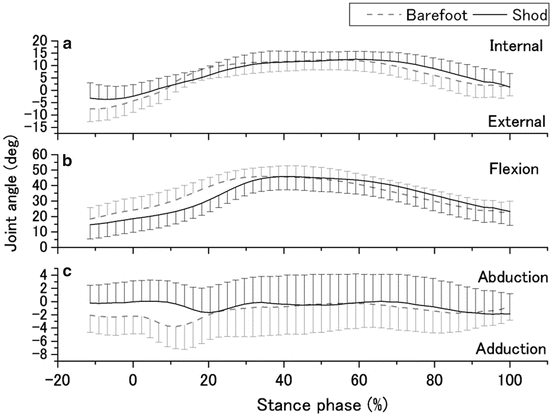Fig. 29.1
Arrangement of markers for the point cluster technique. Twenty-five reflective markers were secured to the left lower extremity of each subject (This is the Author’s Accepted Manuscript of an article published as “Change in tibial rotation of barefoot versus shod running.” as published in Footwear Science Vol.1, No. 1 March 2009, 19–23 copyright Tylor & Francis, available online at http://www.tandfonline.com/ , doi:10.1080/19424280902950456)
Figure 29.2 shows that subjects experienced internal tibial rotation during the period ranging from foot strike to approximately the first half of the stance phase and external rotation during the second half of the stance phase. The data demonstrate that the degree of tibial rotation was reduced with athletic footwear (Table 29.1). This study suggests that the degree of tibial rotation that accompanies foot pronation could be reduced by wearing athletic footwear during running. To improve our understanding of the interaction between the human body and footwear, additional analyses of muscle activation, plantar pressure distribution, and different types and designs of footwear are required.


Fig. 29.2
Average kinematic data of the knee joint during running. Data are presented for knee internal/external rotation (a), knee flexion (b) and adduction/abduction (c) (This is the Author’s Accepted Manuscript of an article published as “Change in tibial rotation of barefoot versus shod running.” as published in Footwear Science Vol.1, No. 1 March 2009, 19–23 copyright Tylor & Francis, available online at http://www.tandfonline.com/ doi:10.1080/19424280902950456)
Table 29.1
Angular change in the knee joint during the 100-ms period after foot strike
Condition | Barefoot | Shod | Difference | |||
|---|---|---|---|---|---|---|
Variable | Mean | (SD) | Mean | (SD) | p value | |
Internal rotation (deg) | 16.0 | (4.1) | 13.7 | (5.3) | * | 0.02 |
Flexion (deg) | 20.8 | (4.9) | 26.5 | (4.2) | * | 0.00 |
Adduction (deg) | 1.1 | (4.1) | 1.2 | (0.4) | – | 0.60 |
29.2.1 A New Approach for Analyzing Foot and Ankle Kinematics with Footwear
Researchers face two major problems when analyzing foot and ankle movement. As discussed in the previous chapter, one of these is the skin movement artifact, which is a commonly encountered issue in the analysis of foot and ankle motion. The second problem is that the researchers are unable to observe the foot when the subjects are using footwear. Consequently, researchers must employ strategies such as use of sandals with straps as footwear or cutting “windows” in the footwear to attach reflective markers on anatomical landmarks; however, these tactics may change the mechanical properties of the footwear.
29.2.2 Foot Arch
The foot arch plays the important role of an impact attenuator during activity. However, there is little information regarding the effects of footwear on foot arch kinematics during dynamic conditions because of the related methodological difficulties. To solve this problem, we used cineradiographic image sequences to determine the effects of footwear on the medial and lateral longitudinal arch kinematics during single leg landing (Fukano and Fukubayashi 2012a).
Stay updated, free articles. Join our Telegram channel

Full access? Get Clinical Tree








